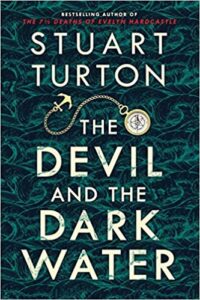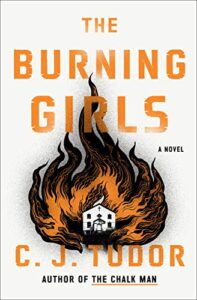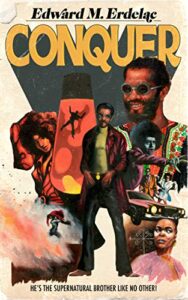( Bookshop.org )
The Devil and the Dark Water by Stuart Turton
Sourcebooks, 2020
ISBN-13 : 978-1728206028
Available: Hardcover, paperback
Stuart Turton probably wouldn’t describe his books as horror, but they are compelling, original, and dread-inducing. In a departure from the surreal Agatha Christie-like The 7 1/2 Lives of Evelyn Hardcastle, in The Devil and the Dark Sea, this story takes place in 1634, on a ship leaving from Batavia (now Jakarta, Indonesia), the center of the Dutch East Indian Trading Company, for Amsterdam, home of the company’s headquarters, a journey of about eight months during which many ships were lost as sea. Readers expecting accurate historical fiction will not find it here: in a note, Turton essentially says he did the research, but threw it out the window if he found it wouldn’t work with his story. By changing as much as he did, he’s basically written an alternate history, which would be fine except that he never identifies it as such, which is unfair to readers unfamiliar with the setting, who will think it’s solidly grounded in the historical period (I guess once someone calls your work genre-bending it’s hard to commit).
Passengers on the Saardam include Jan Haan, the ambitious governor general of Batavia; his wife, Sara Wessell; and their inventive daughter, Lia; his mistress, Creesjie Jens, and her sons; his chamberlain, Cornelius Vos; and guard captain Jacobi Drecht. Also traveling on the ship is Sammy Pipps, a Sherlock-type detective and alchemist of unknown origin who has been accused of spying, and his bodyguard/case recorder, former Lieutenant Arent Hayes. Before the ship leaves, a leper warns the passengers not to leave, warning that the devil “Old Tom” will be their downfall, but the governor general is insistent on leaving for Amsterdam immediately. Complicating things by bringing religion into the mix on a ship where passengers and crew are already uneasy and superstitious, a predikant, or preacher, and his acolyte Isabel, stow away on the ship as well.
Just as the ship sets off, the sail is unfurled to show a symbol that Creesje, the predikant, Arent, and one of the sailors individually recognize and associate with Old Tom. Is the devil really on the ship with the passengers and sailors, are they imagining things, or is someone playing with the characters’ fears in hopes of personal gain? The predikant, a former witch hunter, claims they’ll know for sure once three unholy miracles have occurred. As the ship gets further out onto the open ocean, the unholy miracles are identified, and the weather worsens, the onboard situation gets more violent and treacherous, and it becomes clear that, real or not, Old Tom has followers among the crew. As the histories of the characters and plot twists are unraveled, and the deaths stack up, the situation becomes even more unnerving. Is the ship haunted by Old Tom, or is something else going on?
Turton does a fantastic job of creating a sense of mystery and dread. There is no escape from the ship out on the ocean, just people, most of whom don’t like or trust each other, adrift after a storm. Turton admits he took liberties with history for the purpose of the story, so I don’t know if sailors truly lived continually in such brutal, violent environments, but he paints a vivid picture of the dynamics. Characters who could have been one-dimensional were fully developed: Arent turns out to be the governor general’s nephew, and while Haan might have been terrible to his wife and underlings, he clearly cherishes his relationship with Arent. Haan’s wife Sara could have been set up in opposition to his mistress, but they turn out to be close friends. Sammy and Arent, for all their similarities to Holmes and Watson, are completely different in body type, personality, background, and overarching motivation. I found the very ending unneccessarily brutal, unrealistic and extremely disappointing, and felt it marred the story in a big way, but I felt the atmosphere, character development, and descriptive language still made this worth reading.
The Devil in the Dark Water reveals some very dark aspects of overseas trade and the participants in it during the 1600s. No one comes away untainted. Despite the faulty ending, it’s a tale I won’t soon forget, and I would certainly give Turton another chance.
Contains: violence, gore, murder, implied rape, brutal killing of animals, body horror, mass murder
Reviewed by Kirsten Kowalewski







Follow Us!